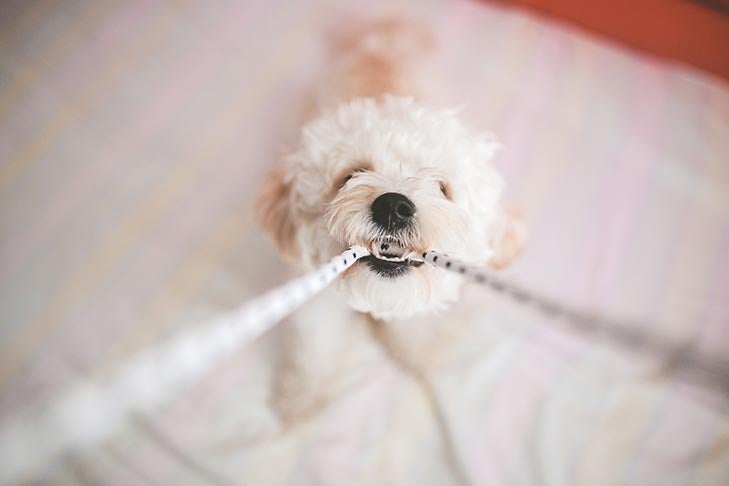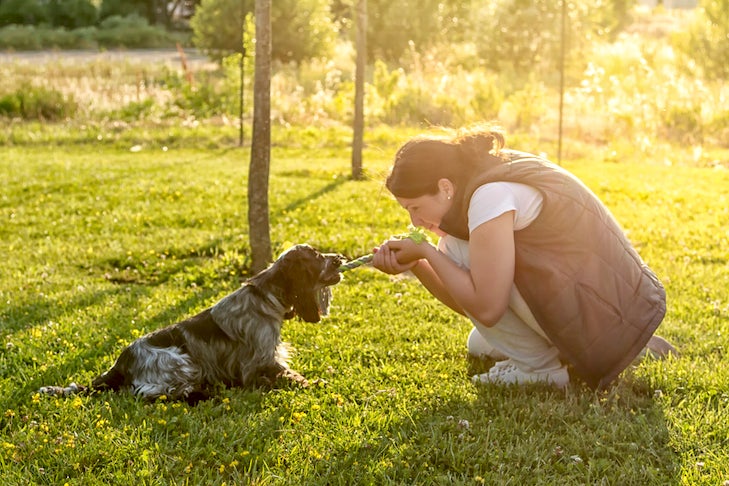Clubs Offering:
Does your dog love playing tug-of-war? Maybe you’ve stopped this type of game after hearing the mistaken belief that it encourages problem behaviors? However, speak to any top dog sports competitor or qualified trainer, and they will tell you that well-managed tug games have many benefits, and there are even scientific studies confirming they don’t promote aggressive or dominant behaviors.
Tug can promote impulse control, build confidence, and strengthen the bond between dogs and their owners. It’s an activity that taps into natural drives, making it a motivational, reinforcing, and high-value training tool. It is also a great way to burn off excess energy and keep your dog physically and mentally stimulated.
By letting your dog “win” during a game of tug, you aren’t letting them dominate you. Instead, you’re nurturing a solid rapport and teaching them that engaging with you is fun and rewarding. Dianna L. Santos (KPA-CTP, CPDT-KA, CNWI) is the Owner and Lead Instructor at the Dog Sport University. “I love the description of “shared holding” when it comes to tug. Allowing a dog to win means they can celebrate with their prize, but it also presents them with a wonderful opportunity: to choose to bring the toy back to you on their own!” she says. “It sounds so simple, but this is a huge shift from most interactions between dogs and handlers. Instead of the handler nagging their dog for the toy or the dog hoarding it away from them, the dog chooses to bring it back to play some more. This is liberating to the dog and can take your relationship to the next level!”

Tug can also build confidence and help your dog to focus on you in distracting environments. Dr. Erica C. Boling is a Certified Canine Fitness Trainer (CCFT) and owner of Northeast K9 Conditioning. She has used tug games with both her Belgian Malinois from an early age. “One of the things I did with my dog when he was younger, I would just put him in the car and take him to different environments, and I didn’t focus on obedience. Instead, it was like “let’s just go and play”, so he can see it is fun and, also, he learns to engage and focus on me versus being all distracted in the environment,” she says. “When he would get stressed and anxious, you could feel him releasing it during a game of tug.”
For dogs that struggle with impulse control, tug is a fantastic way to work on this. “Having a dog who will wait to go for the toy, or will drop it when asked, are crucial elements to the game,” explains Santos. “This ability for the dog to contain their excitement and still think is a skill they will need in day-to-day life as well!”
Santos describes tug as being an art. “Each dog and handler team will need to develop their own approach and technique. Knowing how to present the toy and interact with it, and your dog, during the tug session itself are important mechanical skills to master.”
When done correctly, tug sessions should be “kept relatively short (10-15 seconds), have impulse control built-in (dog should have a trained “OUT” or “DROP” behavior), and be something the dog is invited to do with you,” she says.
“Strive for two to three tugs in a session (tug-trade-tug-win-tug-trade) and then cap it off by asking the dog to do a “thinking” exercise. Give them a treat and then put the tug toy away,” Santos refers to this as interval training. “We allow the dog to get high up into the clouds with excitement and then bring them back down to earth with some fun thinking stuff. Being able to cap off their excitement is a skill every dog needs!”
Santos also points out that “choosing the right tug toy for your dog is key. Pick something that has some length to it (should the dog need to re-grip, they will not get your hand by mistake) and made of a material that is easy on their teeth and gums.”
It’s important to never chase after your dog if they run off with the toy or try to hoard or hide it. You are only teaching them not to listen to you, and they could become possessive of the toy. “The key thing here is that the reward in it is the engagement,” Boling reminds us. “I am going to chase you and you won’t bring it back, versus a dog that learns that, “oh no, when she lets go, the game is over, and I can’t do anything unless I bring it back to her.””

Another key element with tug is making sure you are not playing too rough or too long. Boling has seen many injuries caused by using incorrect techniques or playing tug when a dog has an existing injury. “I have an online canine fitness academy, and students have shared common practices they have seen during tugging that make me cringe,” she says.
There are a couple of things she always advises. “Number one is I recommend you try to keep the spine in a neutral alignment. I see a lot of people that will take the tug, and they are just yanking it up and down, the dog’s feet are coming off the ground, and the neck is all contorted and twisted.”
Secondly, Boling also recommends that you moderate the pressure based on the type of dog. There should only be light resistance when playing tug with young puppies or with senior dogs who might have physical issues, and they should engage with the toy more than you do.
When it comes to dogs involved in high impact sports or other exercise that is hard on the body, Boling also points out that “there might be issues going on in the neck or the spine, and we don’t really know because a lot of these dogs don’t easily show pain.” Always be vigilant for the subtle signs of pain, get your dog checked out by a vet if you have any concerns, and, as Boling reminds us, “be extra careful and think of neutral spine, neutral spine. Try to keep the dog in alignment, keeping those feet low on the ground, and adjusting the pressure.”
Of course, not every dog is motivated by this type of game. For some, a different type of toy, a tasty food morsel, or even praise is a better reward. It is usually the highly energetic, focussed breeds that enjoy tug. Those with working drives, like Belgian Malinois, Collies, Bully breeds and Terriers, are often fans.
A note for our readers: If you have an urgent question and are unable to ask your veterinarian, you can use the Ask a Vet service that will give you access to a veterinarian for 7 days for $1.
When shes not geeking out about dogs, you can find her reading, hiking with her two Cardigan Welsh Corgis, or paddleboarding.
Cathy is certified through the Certification Council of Professional Dog Trainers, holding both the CPDT-KA and CBCC-KA designations. Cathy is a Fear Free Certified Certified Professional, a member of the Association of Professional Dog Trainers, the Pet Professional Guild, and the Dog Writers Association of America.
As Preventive Vets dog behavior expert and lead trainer at Pupstanding Academy, Cathy focuses on helping humans and their pets build a strong relationship based on trust, clear communication, and the use of positive reinforcement and force-free methods. With over 13 years of experience, she has had the opportunity to work with hundreds of dogs on a wide variety of training and behavior issues. Beyond her one-on-one consultations through Pupstanding Academy, she also teaches group dog training classes at Seattle Humane. Her specialties include dog aggression, resource guarding, separation anxiety, and puppy socialization.
Our mission is to help save dogs and cats’ lives through our educational content. To support our efforts, this page may contain affiliate links. We earn a commission for qualifying purchases – at no cost to you.
Here are some tips to keep in mind:
You won’t want to play tug of war with your puppy while they are in the middle of their “puppy crazies” (this is typically a good time to provide calming enrichment like a filled snuffle mat or stuffed Kong and a cozy place to nap, rather than interactive play). Instead, choose a moment where they are awake and active but not wild and mouthy. *Sometimes redirecting to toys can be helpful, but oftentimes the “zoomies” are a reflection of your puppy being overtired or having pent-up energy to burn. In moments like these, they are rarely gentle in their interactions and playing tug will increase their heart rate, potentially creating more rough play.
Excited puppies rarely make careful choices with their mouths. To decrease the likelihood your puppy will bite your hand rather than the toy, only play with long toys! You can buy and braid strips of fleece to create a nice long tug toy, buy a tug toy from a retailer, or attach the previously mentioned braids of fleece to your puppy’s favorite toys. To check if your toy is long enough when standing hold the toy in your hand and rest your hand straight down at your side. The toy should be touching the ground. If it is hovering above the ground while you’re holding it, it is too short for a tug with your puppy right now!
Should You Play Tug Of War With Your Dog Or Puppy?
Tug of war is a challenging and fun game that involves two or more people pulling on opposite ends of a rope, trying to tug the other person across a line.
It is a typical game children play and can also be enjoyed by adults – but, is tug of war bad for dogs? While it may seem like harmless fun, this game can be dangerous for dogs.
Dogs have a tendency to get over-excited during games of tug of war and may become aggressive if they feel they are losing. This can lead to injuries for both people and dogs.
Another problem with overexcitement is it can reinforce past traumas. For example, if you adopted a dog who was previously used in a dogfighting ring, it is best to avoid tug of war because it may trigger aggressive behavior.